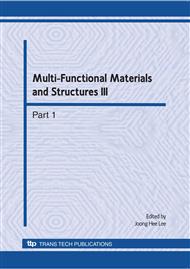p.59
p.65
p.69
p.73
p.77
p.81
p.85
p.89
p.93
Fabrication and Properties of 1-3-2 Piezoelectric Composites
Abstract:
In this paper, the 1-3-2 piezoelectric composites were fabricated by the cut-filling technique using P(MN)ZT piezoelectric ceramic as functional materials and polymer as matrix. The effects of ceramic volume fraction on the electrical properties of the composites were studied. The results indicate that as the ceramic volume fraction increases, the piezoelectric stain factor d33 increases evidently, while the piezoelectric voltage factor g33 decreases. Besides, the planar electromechanical coupling factor Kp and mechanical quality factor Qm of the composite are also less than those of the pure ceramic, while the thickness electromechanical coupling factor Kt is larger than that of the ceramic.
Info:
Periodical:
Pages:
77-80
Citation:
Online since:
August 2010
Authors:
Price:
Сopyright:
© 2010 Trans Tech Publications Ltd. All Rights Reserved
Share:
Citation:


